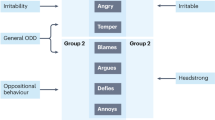Abstract
Oppositional defiant disorder in childhood is a predictor of later mood disorders. This study assessed whether groups of children can be identified by their course of co-occurring oppositional and depressive symptoms in childhood using group based trajectory modeling. Participants were a cohort of 932 4 or 5 year old offspring of women participating in the National Longitudinal Study of Youth whose symptom trajectories were modeled across ages 4–13 years. Three co-occurring trajectory groups were found: oppositional symptoms only (23%), oppositional symptoms preceding increasing depressive symptoms over time (16%) and absence of any symptoms (61%). Of all children who developed depressive symptoms, all had moderate or high levels of pre-existing oppositional symptoms. Oppositional symptoms typically precede, or co-occur with depressive symptoms in childhood.


Similar content being viewed by others
References
Loeber R, Burke JD, Lahey BB, Winters A, Zera M (2000) Oppositional defiant and conduct disorder: a review of the past 10 years, part I. J Am Acad Child Adolesc Psychiatry 39:1468–1484
Angold A, Costello EJ, Erkanli A (1999) Comorbidity. J Child Psychol Psychiatry 40:57–87
Boylan K, Vaillancourt T, Boyle M, Szatmari P (2007) Comorbidity of internalizing disorders in children with oppositional defiant disorder. Eur Child Adolesc Psychiatry 12:484–494
Maughan B, Rowe R, Messer J, Goodman R, Meltzer H (2004) Conduct disorder and oppositional defiant disorder in a national sample: developmental epidemiology. J Child Psychol Psychiatry 45:609–621
Nock MK, Kazdin AE, Hiripi E, Kessler RC (2007) Lifetime prevalence, correlates, and persistence of oppositional defiant disorder: results from the national comorbidity survey replication. J Child Psychol Psychiatry 48:703–713
Copeland WE, Shanahan L, Costello EJ, Angold A (2009) Childhood and adolescent psychiatric disorders as predictors of young adult disorders. Arch Gen Psychiatry 66:764–772
Capaldi DM, Stoolmiller M (1999) Co-occurrence of conduct problems and depressive symptoms in early adolescent boys. IIII. prediction to young-adult adjustment. Dev Psychopathol 11:59–84
Stringaris A, Goodman R (2009) Longitudinal outcome of youth oppositionality: irritable, headstrong, and hurtful behaviors have distinctive predictions. J Am Acad Child Adolesc Psychiatry 48:404–412
Burke JD, Hipwell AE, Loeber R (2010) Dimensions of oppositional defiant disorder as predictors of depression and conduct disorder in preadolescent girls. J Am Acad Child Adolesc Psychiatry 49:484–492
Costello EJ, Mustillo S, Erkanli A, Keeler G, Angold A (2003) Prevalence and development of psychiatric disorders in childhood and adolescence. Arch Gen Psychiatry 60:837–844
Center for Human Resource Research (2004) NLSY79 Child and young adult data users guide: a guide to the 1986–2002 child data and 1994–2002 young adult data. The Ohio State University, Columbus
Radloff L (1977) The CES-D scale: a self report depression scale for research in the general population. Appl Psychol Meas 1:385–401
Jones BL, Nagin DS, Roeder K (2001) A SAS procedure based on mixture models for estimating developmental trajectories. Sociol Method Res 29:374–393
Parcel TL, Menaghan ED (1988) Measuring behaviour problems in a large cross-sectional survey: reliability and validity of the NLS youth. Research report. Ohio State University Center for Human Resource Research, Columbus, OH
Peterson JL, Zill N (1986) Marital disruption, parent-child relationships, and behavior problems in children. J Marriage Fam 48:295–307
American Psychiatric Association (2001) Diagnostic and statistical manual of mental disorders. fourth edition - text revisions (DSM-IV-TR). American Psychiatric Association Press, Washington
Boylan K, Georgiades K, Szatmari P (2010) The longitudinal association of oppositional and depressive symptoms across childhood. J Am Acad Child Adolesc Psychiatry 49:152–159
Corcoran K, Fisher J (2000) Measures for clinical practice: a source book. Free Press: New York
Santor DA, Zuroff DC, Ramsay JO, Cervantes P, Palacios J (1995) Examining scale discriminability in the BDI and CES-D as a function of depressive severity. Psychol Assess 7:131–139
Poe GS (1986) Design and procedures for the 1981 child health supplement to the national health interview survey. Working paper series. National center for health statistics, Hyattsville
Ross CE, Mirowsky J, Huber J (1983) Dividing work, sharing work, and in-between: marriage patterns and depression. Am Sociol Rev 48:809–823
Santor D, Coyne J (1997) Shortening the CES-D to improve its ability to detect cases of depression. Psychol Assessment 9:233–243
Nagin DS (2001) Analyzing developmental trajectories: a semi-parametric, group-based approach. Psychol Method 4:139–157
D’Unger A, Land KC, McCall PL, Nagin DS (1998) How many latent classes of delinquent/criminal careers? Results from mixed poisson regression analyses of the London, Philadelphia and Racine cohort studies. Am J Sociol 103:1593–1960
Raftery AE (1995) Bayesian model selection in social research. Soc Method 25:111–163
Roeder K, Lynch K, Nagin D (1999) Modeling uncertainty in latent class membership: a case study in criminology. J Am Stat Assoc 94:766–776
Bongers IL, Koot HM, van der Ende J, Verhulst FC (2004) Developmental trajectories of externalizing behaviors in childhood and adolescence. Child Dev 75:1523–1537
Dekker MC, Ferdinand RF, van Lang ND, Bongers IL, van der Ende J, Verhulst FC (2007) Developmental trajectories of depressive symptoms from early childhood to late adolescence:gender differences and adult outcome. J Child Psychol Psychiatry 48:657–666
Sterba SK, Prinstein MJ, Cox MJ (2007) Trajectories of internalizing problems across childhood: heterogeneity, external validity, and gender differences. Dev Psychopathol 19:345–366
Hankin BL, Abramson LY, Moffitt TE, Silva PA, McGee R, Angell KE (1998) Development of depression from preadolescence to young adulthood: emerging gender differences in a 10-year longitudinal study. J Abnorm Psychol 107:128–140
Fristad MA, Verducci JS, Walters K, Young ME (2009) Impact of multifamily psychoeducational psychotherapy in treating children aged 8 to 12 years with mood disorders. Arch Gen Psychiatry 66:1013–1021
Luby JL (2009) Early childhood depression. Am J Psychiatry 166:974–979
Acknowledgments
This research was supported by a graduate fellowship from the Canadian Institutes of Health Research (KB) and a research training award from the Canadian Child Health Clinician Scientist Program (KB).
Author information
Authors and Affiliations
Corresponding author
Rights and permissions
About this article
Cite this article
Boylan, K., Vaillancourt, T. & Szatmari, P. Linking Oppositional Behaviour Trajectories to the Development of Depressive Symptoms in Childhood. Child Psychiatry Hum Dev 43, 484–497 (2012). https://doi.org/10.1007/s10578-011-0277-7
Published:
Issue Date:
DOI: https://doi.org/10.1007/s10578-011-0277-7




